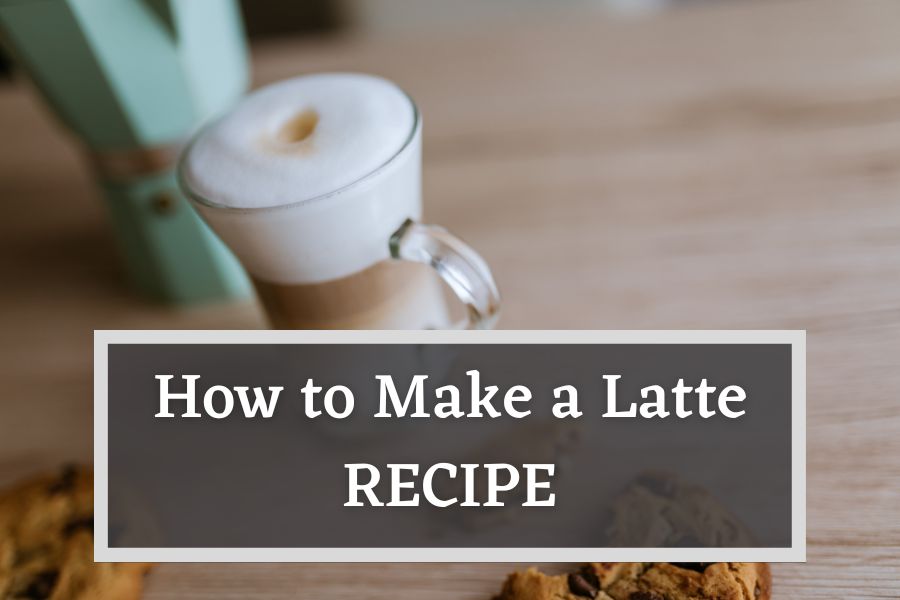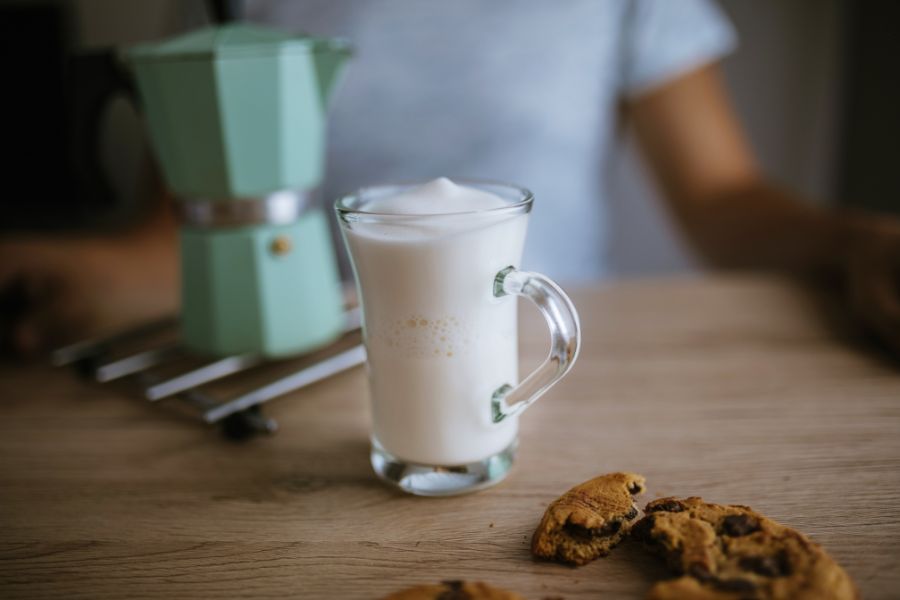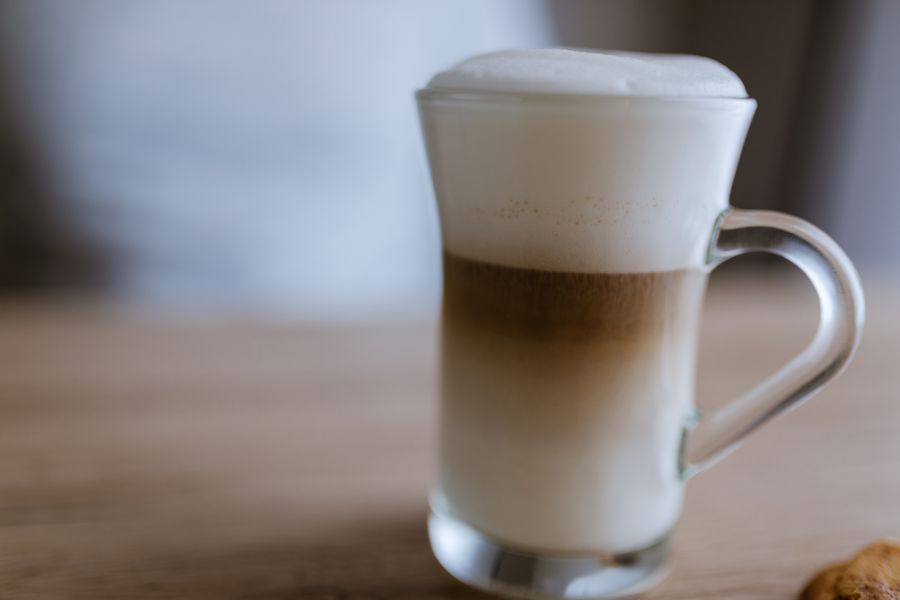Ahh, the latte. It’s the perfect way to start your morning or wind down in the evening. But, how to make a latte? What is the exact latte recipe? Can you make it from home? What tools do you need to make one?
While making a latte at home may seem intimidating at first, it really doesn’t have to be.
With just a few simple steps and quality ingredients you can make yourself a cafe-style latte right at home without spending all that extra money on expensive cafe drinks every day.
Read on our recipe to learn how you too can get barista-level results with your own homemade lattes!

How to Make a Latte
A latte is a classic Italian coffee beverage featuring espresso and steamed milk. This combination gives the latte its signature creamy texture and flavour.
It has become one of the most popular espresso drinks around the world due to its rich, comforting flavour and creamy texture.
I’m guessing that’s the reason why you are here trying to learn how to make one.
So let’s skip the foreword and start making your latte!
Ingredients & Tools You Need:
Making a latte at home can be quite easy with the right ingredients and equipment. To make a latte, you’ll need:
- espresso shot (single or double)
- 6 ounces of fresh whole milk
- flavoured syrup (optional
- milk frother (optional)
- espresso machine or stovetop espresso maker
- a latte cup or a coffee jug
By the way, if you are an espresso beginner and you don’t own a machine yet, but you would like to, check out our best espresso machines for beginners.
Step-By-Step Latte Recipe:
- First, you’ll need to brew your espresso. An espresso machine is the most reliable way of making coffee for a latte but you can also use a stovetop espresso maker if that’s what you have available. Make sure the coffee grounds are finely ground for the best result. Fill your portafilter basket with ground coffee and press it firmly into place on your machine. When brewing, let the water run through slowly to ensure extraction of all the flavours and aromas from the espresso grounds. Once brewed, pour your espresso into a cup or mug. If you need a detailed step-by-step, here is how to make espresso at home.
- Next, you’ll need to steam your milk. Use whole milk whenever possible as it has more fat content which helps create velvety foam when steaming. Pour cold milk into your steam pitcher until it’s just below half full and place it onto the steam wand on your machine (or stovetop). Dip the tip of the wand slightly into the cold milk before turning on (or lighting) it to allow air to escape then turn it up slowly to increase pressure for a few seconds before reducing speed again until you hear a hissing sound coming from inside of your pitcher as aeration takes place – this should take about 15-20 seconds total. Finally, hold back any remaining foam with a spoon or spatula before pouring it into your cup or mug of espresso.
- The last step is combining both elements together: Slowly pour steamed milk onto coffee in circles until the desired ratio is achieved – typically 1/3rd espresso and 2/3rds steamed milk for a classic latte mix – stirring gently between each addition will help combine them together without introducing too many bubbles in the process. If desired then top off with some freshly made foam using a spoon or small whisk; sweeten lightly to taste with sugar if necessary and enjoy!

Ways to Steam Milk for a Latte
Using a Milk Frother:
A milk frother is a simple and easy way to steam milk for making lattes and cappuccinos.
To use, pour the desired amount of cold, whole milk into the frother’s pitcher and turn it on. The frother will heat and aerate the milk as it whips up into a creamy foam.
Once you’re happy with the texture and temperature of the foam, turn off the frother, pour your steamed milk over espresso and enjoy!
Using a Steam Wand on an Espresso Machine
This is one of the most popular ways to steam milk for lattes because many espresso machines come with this feature. We also have a guide on how to use the espresso machine.
To use, place the end of the wand near the bottom of cold, whole milk in a container. Turn on the machine and slowly lower the wand until just below the surface of the milk.
This will create turbulence that causes bubbles in the liquid while heating it at the same time.
When the desired temperature has been reached (caution- may be hot!), turn off the machine and pour steamed milk onto the espresso. Enjoy your latte!
Using a French Press
You can also use a French press to steam your milk for lattes.
Begin by pouring cold, whole milk into a carafe or container that fits your French press snugly. Place plunger on top of carafe then repeatedly plunge up-and-down while moving plunger around inside container in circular motions (this will help ensure even heating).
Continue plunging until the desired temperature has been achieved (again caution- may be hot!). Then pour steamed milk over espresso and enjoy your latte!
Using a Stovetop Pot
If you don’t have any special equipment available for steaming your latte, you can always rely on using a stovetop pot instead.
Begin by pouring cold, whole milk into the pot then place on medium heat setting. Stir continuously with a whisk until the desired temperature has been reached (caution- may be hot!).
Then remove from the heat source and pour steamed milk over espresso for a delicious latte treat!

Frequently Asked Questions About Making a Latte
What kind of milk is best for making a latte at home?
When making a latte at home, the best type of milk to use is fresh whole milk. Fresh whole milk will give your latte a richer flavour with a thicker and more luxurious texture.
Skimmed or semi-skimmed milk produces a latte with a thinner consistency and milder taste.
Any kind of alternative milk such as almond, soy or coconut can also be used, however, they tend to have a slightly different flavour profile and may not be as creamy.
What is the ideal temperature for steaming milk for a latte?
The ideal temperature for steaming milk for a latte is 165°F (73.9°C).
Many latte art tutorials say that steaming the milk to this temperature helps create microfoam, resulting in velvety-smooth, aesthetically pleasing latte art.
How do I know when to stop steaming the milk for a latte?
Knowing when to stop steaming the milk for a latte can be tricky. It is important to pay attention to when the milk has reached its desired consistency and temperature.
The correct texture can be determined by tossing a few drops of milk onto the countertop and watching how it forms — if it forms tight peaks, then the latte is ready to pour.
Can I make a latte without an espresso machine?
While latte generally refers to espresso-based drinks, you can still make a latte without an espresso machine. You can use strong brewed coffee rather than espresso and mix it with cold or steamed milk.
However, if you are not going to use espresso with its rich crema, you can forget about making latte art.
What is the proper ratio of espresso to milk in a latte?
Finding the ideal ratio of espresso to milk for the latte can be tricky. Generally, a latte will consist of one-third espresso and two-thirds steamed milk.
Of course, this ratio is adjustable based on personal preference – some people prefer a latte with more or less espresso.
Can I use flavoured syrups in my homemade latte?
The answer is yes –syrups like hazelnut, caramel, and vanilla are great additions to coffee beverages.
However, be sure to take the time to find high-quality syrups that won’t ruin your latte – some syrups contain artificial sweeteners and preservatives you might not want in your brew.
What kind of espresso beans should I use for a latte?
Depending on your own preference and what flavour profile you’re going for, you may decide to go with a blend of arabica and robusta beans, or just opt for pure arabica.
Espresso blends are often a great choice because they give you the best of both worlds: The round sweetness of arabica combined with the bold body of robusta.

Now You Know How to Make a Latte
Knowing how to make a latte at home is no longer a problem!
Whether you’re looking for an energizing morning cup or an evening pick-me-up, it’s easy to recreate barista-style beverages from the comfort of your own kitchen by following the steps from above.
So, why not break out your mugs and coffee makers and have some fun learning how to make a delicious homemade latte?
And while you are at it, why not also learn how to make a flat white and even a delicious cup of americano?
What To Do Next?
I hope you enjoyed this post about making a latte. I know have enjoyed preparing it for you.
Do you have any more questions about the topic? Let me know in the comments below!
Interested in learning more about espresso drinks? My team and I invite you down to the rabbit hole. Check out our top espresso guides and recipes and keep on learning!
